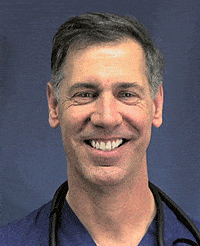
Mark Ackerman, PA-C
By Mark Ackerman, PA
In the 1800’s there was a man known by the name of “The Great Blondin” who was the first person to cross Niagara Falls on a tightrope. In front of a crowd of about 5,000 and at an elevation of 160 feet above the Niagara gorge, he walked on a 2 inch diameter cable stretched 1,100 feet across the river.
As the story goes, the crowd was so amazed they started shouting “do it again, do it again!” Charles Blondin, ever the showman, shouted back to them “Do you believe I can do it again?” and the crowd answered “yes, we believe you can do it again.” Blondin then asked them “do you believe I can do it again while being blindfolded?” and the crowd excitedly shouted back “Yes we believe you can do it while being blindfolded. Then the showman asked them, “Do you believe I can do it again blindfolded while pushing a wheelbarrow across the cable?” “Yes,” the crowd answered, “we believe you can do it blindfolded while pushing a wheelbarrow!” So Blondin asked them again, “Do you believe I can walk across the cable while blindfolded, pushing a wheelbarrow with someone in the wheelbarrow?” “Yes” the crowd shouted back with even more excitement and intensity than before, “We believe, we believe!” At which Blondin shouted back, “Ok, I need a volunteer!” and the crowd suddenly became silent.
The moral of the story is that, while we often believe in things intellectually, we don’t always have faith. Faith really has 2 components. The first is belief, the intellectual assent that something can or will be done. The second component is trust, the belief that, even when things aren’t perfect or ideal, we are going to come out of a situation doing well. So faith is really about belief and trust. We may believe that The Great Blondin can push somebody over a high wire in a wheelbarrow, but we don’t have enough trust to get into the wheelbarrow.
I think there is a similarity between this story and the belief we have in our physicians. We believe that they are highly intelligent and have mastered a lot of medicine but sometimes we really lack the trust needed to take their advice. We have difficulty getting into the “medical wheelbarrow” as it were.
The interesting thing is that nowadays, more and more people are putting trust in their own research by asking Dr. Google a few questions than they do trusting their own physician… It is estimated that at least 50% of patients have already looked up their symptoms on the internet and have diagnosed themselves before they come in for a Doctor appointment. And when the diagnosis from our personal physician doesn’t agree with our diagnosis from the internet, we tend to think the physician is the quack and not the internet.
I think one of the problems here is that we don’t consider how medical diagnoses are very dependent on being able to differentiate between two disease processes that are similar. While we may get correct answers from the internet, we also don’t know what information needs to be put into the system in order to get the answer. These other inputs are things like, physical exam findings, lab tests and imaging studies, but they are also things like just understanding what problems are common and what questions to consider asking.
To help with this, I am going to list some questions that need to be asked in the process. These are things that can tease out the difference between 2 very similar disease processes. This list, is fondly referred to as “The Sacred Seven.”
The Sacred Seven:
1. When did your symptoms start (minutes, hours, days, weeks etc.)?
2. Are your symptoms constant or intermittent?
3. What makes your symptoms better or worse (positional changes, foods, etc.)?
4. What factors are associated with your symptoms (i.e. what other symptoms occur with the primary symptom- nausea, shortness of breath etc.?
5. Is there any radiation of your symptoms?
6. What is the character of your symptoms (sharp, dull, heavy)?
7. Location of symptoms (body part(s).
In addition to just simply figuring out a diagnosis when a patient has a complaint. I think it is really important to have your physician help to anticipate future diagnosis based on current data. It is hard sometimes for us to consider preventative care measures today when we don’t have a problem. But docs are always considering, what disease is the patient at risk for in the future?
So while we might want to do a colonoscopy at this time in our lives, it may be the very thing that saves our lives in the future. Just like we trust our Plummer when he says to replace a pipe that may not be leaking now, we need to trust our physician when we are advised to look at our risk for future problems.
So back to The Great Blondin. While he never did push a wheelbarrow over a tight rope at Niagara Falls, my understanding is that he did push one over other high wires later in his life. He did walk some of these blindfolded and carried people across with him as well. So the next time you go to the doctor. Have some faith, get into the wheelbarrow and let them steer you to better health. And, be prepared to answer the sacred seven questions above. It will help your doctor to have faith in you as well!
